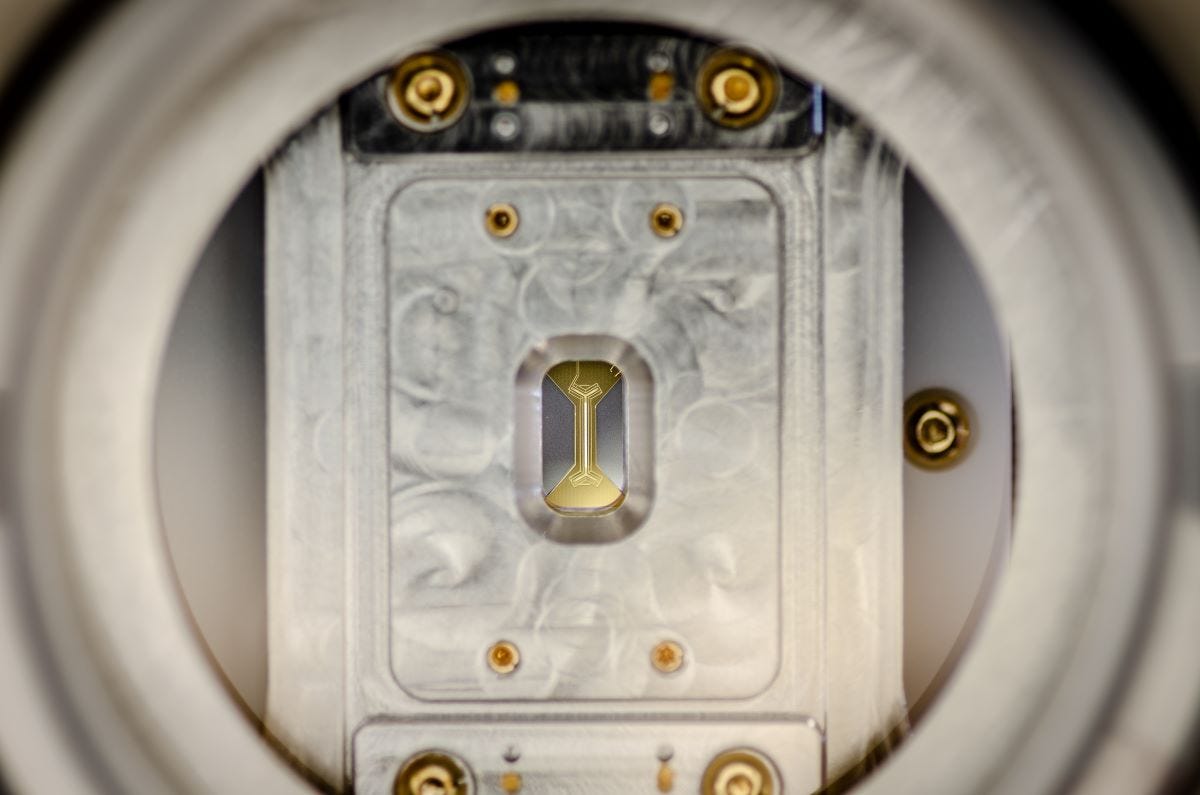
Quantum computers, to an extent, are the modern-day equivalent to the computers of the 1950s.
Image: IonQ
With all of the excitement surrounding quantum computing coming from researchers, businesses and even governments, it’s tempting to envision a future in which Amazon Prime Day deals would include alluring discounts on the latest-generation quantum computers, ready for next-day delivery to your door.
After all, the first classical computers built in the middle of the 20th century were gigantic systems that were seen at the time as the pinnacle of technology, only to be accessed by white-coated researchers in secretive labs. For most people, the idea of using a computer for day-to-day applications seemed simply ludicrous.
But with the mass production of powerful microprocessors on semiconductor chips in the 1970s, hobbyists were suddenly able to own a personal computer. The reception was overwhelmingly enthusiastic, and the rest is history: today, hundreds of millions of PCs ship every year around the world.
So should we expect quantum computing to follow the same path? Quantum computers, to an extent, are the modern-day equivalent to the those giant computers of the 1950s. They sit, surrounded by huge amounts of elaborate equipment, in specialised laboratories. Very few devices currently ship commercially, and those that do come at an exorbitant price.
Yet the promise of quantum computing is seemingly immense. According to the experts, the technology is a completely new paradigm that could even prevent the breakdown of Moore’s law — the idea that manufacturers are packing an ever-increasing number of transistors on ever-smaller chips, meaning that we are inevitably nearing the physical limits of compute power.
By leveraging the properties of weird physics known as quantum mechanics, quantum computers could in principle increase the available compute power exponentially. This would mean finding answers to problems that are impossible to solve in any reasonable time for classical computers — think simulating new materials with extreme precision, or forecasting climate variations with great accuracy.
It isn’t a stretch, therefore, to anticipate that such great tools will gradually make their way into consumers’ lives once they are ready for commercialisation, and even that they will replace the computers that we are familiar with today.
Not so fast, warns Bill Fefferman, assistant professor in the computer science department at the University of Chicago. “Quantum computing is hugely exciting, but maybe not for the reasons that people think it’s exciting,” Fefferman tells ZDNet.
“Quantum computing will not be a general-purpose speed-up on all problems. We actually have a lot of evidence showing that for mini-tasks, we won’t be able to get meaningful speed-up on a quantum computer.”
Everyday processes that involve the manipulation of transactional data — buying an item or checking revenue projections, for example — are much better carried out by classical computers, and so are database applications. Emailing, voice and video calling, or social media scrolling all work fine on existing phones and laptops, and there’s very little that quantum computers are expected to change in this realm.
This is why even in 100 years, says Fefferman, when a universal fault-tolerant quantum computer might be available, consumers will still using classical computers for many, if not most, tasks.
What quantum computers are expected to excel at is a set of specific use cases. Examples include computation in chemistry and physics, for example to discover better antibiotics and medications; but researchers are also investigating potential use cases in machine learning and AI, as well as ways that quantum computing could speed-up optimisation problems in industries like finance or transportation.
For those specific applications, quantum computing could provide an extreme speed-up that will come on top of classical computing. The concept is similar to the use of Graphics Processing Units (GPUs), which can enhance a Central Processing Unit (CPU) for certain use cases like machine learning. On top of a GPU, therefore, scientists and engineers might one day have the choice of tapping into the capabilities of a Quantum Processing Unit (QPU).
But even if using a QPU, classical computers will still be central to the computation. “You can’t send a job, called a circuit, to run on a quantum computer without involving a classical computer,” Bob Sutor, chief quantum exponent at IBM, tells ZDNet. “Similarly, you can’t get the answer back without using classical computers near the quantum system and on the cloud.”
When executing a quantum program, developers use classical hardware like a laptop to send queries over the cloud to the quantum hardware. This is why IBM is working on developing integrated classical and quantum computing: for example, earlier this year the company released a tool called Qiskit Runtime, which helps reduce the latency between the quantum processor and the classical device making queries.
Latency is a particular area of focus for IBM, because it seems unlikely that developers working on quantum computers will be located near the devices.
Quantum systems currently require highly specialised laboratory environments, along with bulky and complex equipment. IBM’s quantum computers, for example, need to be kept at a temperature of about -270 degrees Celsius to function. So although the technology is set to become more practical as it scales, there’s little indication that quantum devices will make their way into offices and households anytime soon.
Access will instead largely be cloud-based, predicts Sutor. “Even though your phone and laptop have great apps, under the covers, those apps are reaching out across the internet to compute on one or more clouds,” says Sutor. “You may have your phone in your hand, but you do not have all the computing power of the cloud in your home or business. So when it comes to quantum computing, we can ask: ‘Why not do it on the cloud?'”
It might even be that users don’t realise that they are tapping into the resources of a quantum computer to run certain applications, just like you may not be aware of the fact that you are using the cloud pretty much daily for applications on your iPhone or Android handset.
All of the major cloud providers — AWS, Microsoft Azure and Google Cloud — now offer access to quantum computing in some shape or form. Smaller companies are also emerging in the space with cloud-based quantum offerings: UK start-up Oxford Quantum Circuits, for instance, has made a private cloud service available to access its superconducting quantum computer. This is giving rise to the concept of quantum computing as-a-service (QCaaS), a term increasingly making its way into the business jargon of the quantum ecosystem.
That said, some specialist users will still require the computational capacity of their own quantum computer. The Cleveland Clinic, for example, has already signed a partnership to build its own quantum system on-premises, to contribute to research dedicated to public health threats such as the COVID-19 pandemic.
And research is ongoing to reduce the size of quantum systems in order to make them fit into regular data centres. The EU recently launched a €10 million project ($11.6 million) dedicated to creating a compact quantum computer that meets industry standards without needing an ultra-stable lab environment for operation. In recent news, scientists working on the initiative successfully set up a fully functional ion trap quantum computer into two 19-inch server racks, as typically found in data centres around the world.
In that context, the prospect of quantum computers one day going mainstream seems a lot more realistic — realistic enough, even, to imagine that consumer-scale systems could one day, in a distant future, hit retail shelves. Quantum computers will never replace phones and laptops when opening a Word document or messaging a friend; but those were applications that scientists working on classical computers in the 1950s never dreamed of. It’s impossible to predict, therefore, what quantum computers might unlock over the course of the next century.


